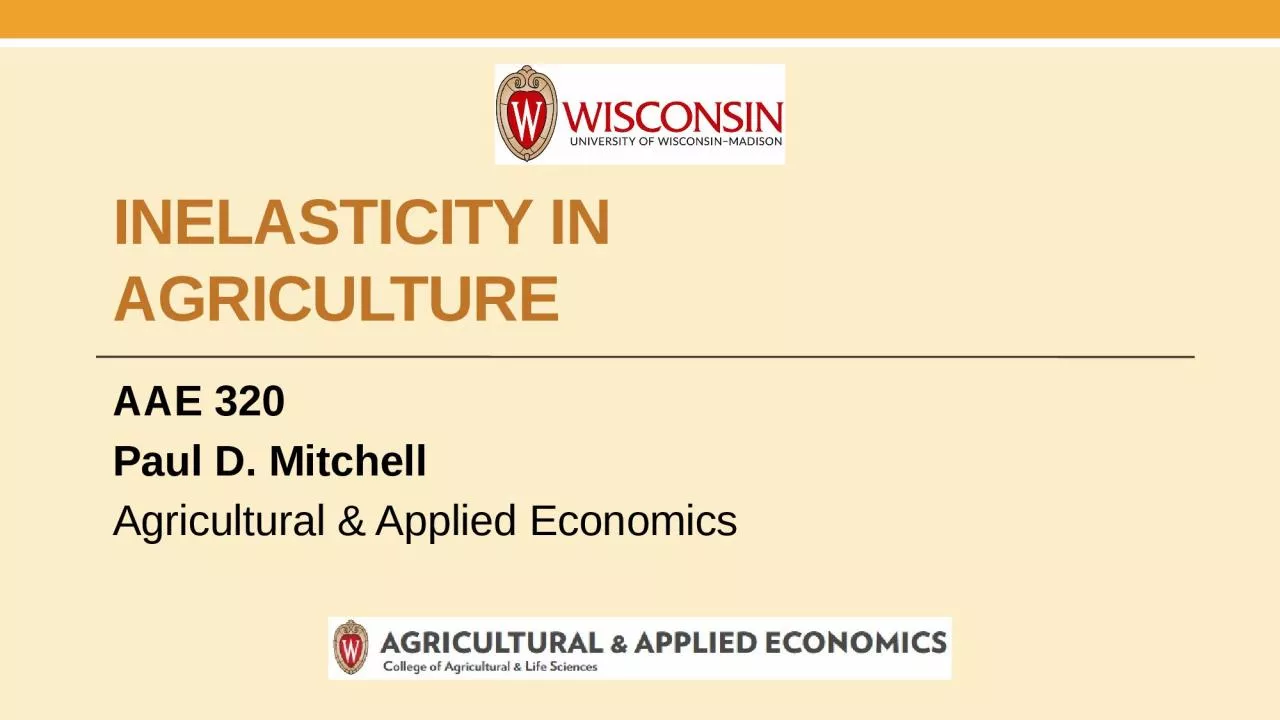

AAE 320 Paul D Mitchell Agricultural amp Applied Economics Learning Goal Become aware that ag supply and food demand are relatively inelastic compared to many other types of supply and demand ID: 1027853
Download Presentation The PPT/PDF document "Inelasticity in Agriculture" is the property of its rightful owner. Permission is granted to download and print the materials on this web site for personal, non-commercial use only, and to display it on your personal computer provided you do not modify the materials and that you retain all copyright notices contained in the materials. By downloading content from our website, you accept the terms of this agreement.
1. Inelasticity in AgricultureAAE 320 Paul D. MitchellAgricultural & Applied Economics
2. Learning GoalBecome aware that ag supply and food demand are relatively inelastic compared to many other types of supply and demandUnderstand the impacts of this inelasticity on ag prices, farm income and consumer spending on foodMeans large price swings for small supply/demand quantity changes and small supply/demand quantity changes for large price swingsMeans large swings in farm income and consumer spending on food
3. ElasticityEconomists use the term “elasticity” to talk about the “responsiveness” between factors that are connectedHow responsive one factor is to changes in another factorOwn price elasticity, income elasticity, cross price elasticityOwn Price Elasticity: How price responds to changes in quantity of supply (or demand)Percentage change in price divided by percentage change in quantityHow much price changes in % if have a sudden supply or demand “shock”Own Price Elasticity = %DP / %DQLike a slope, but normalized by using percentage changes so does not depend on units of measure used
4. Why is food demand relatively inelastic?Biological: There are no substitutes for food, we have to eat, but we can only eat so muchSocial/Cultural: Many foods and diets are culturally set, slow to change, even with large price swingsWhy is agricultural product supply relatively inelastic?Biological: Long crop and livestock life cycles: once the crop is planted or the cow is pregnant, supply “locked in” and can’t change quickly in response to price changesSocial/Cultural: Few uses for land other than agriculture and farmers tied emotionally to agriculture
5. PriceQuantityPriceQuantityInelastic Supply and DemandElastic Supply and DemandAgricultural supply and food demand curves are relatively inelastic in quantity, So What!Both curves are steep in quantity, flat in priceBoth curves are flat in quantity steep in price
6. PriceQuantityPriceQuantityPriceQuantityPriceQuantityInelastic Supply and DemandElastic Supply and DemandSame-sized supply shiftLarge Price ChangeSmall Price Change
7. PriceQuantityPriceQuantityPriceQuantityPriceQuantityInelastic Supply and DemandElastic Supply and DemandSame-sized demand shiftLarge Price ChangeSmall Price Change
8. Implications of Inelastic Supply & Demand for Food/Ag ProductsLarge price changes for small quantity changesSmall quantity changes for large price changesTariffs cause milk prices to drop, but farmers still milk cows every day and don’t start selling cowsQuinoa prices skyrocket as farmers race to keep up with demand, then prices drop fast once market suppliedSame thing for sweet cherries, peaches, new potatoes, … when they first come inPeople keep buying milk in store even if prices go upIf beef prices plummet, people don’t start eating beef for breakfast, lunch and dinnerAg/food supplies and demands often vary due to weather, disruptions, food fads/scares – so prices vary greatly
9. CBOT Weekly Average Price for December 2018 Cornhttps://www.investing.com/commodities/us-corn-historical-data18.5% decrease from $4.05 to $3.40(May 20 to July 8)
10. Dec 2020 Corn Futures PriceApproximately $4.03 in January 2020 to a low of about $3.23 in June, then recovered 20% drop and then a full recoveryPandemicWeatherTrade
11. Income effects of highly variable prices Farmers bear the costs of price variability because they are inelastic. Do not or cannot respond to crop and livestock price changesLose money when prices are low and make money when prices are high
12. SummaryAgricultural supply and food demand are relatively inelastic: Non-responsive to price changesBiological and cultural reasons for theseLarge price swings for small supply/demand quantity changesSmall supply/demand quantity changes for large price swingsLarge swings in farm income and consumer spending on food as weather, policy and other factors shock the systemThe effects of this inelasticity on farm income and consumer spending are important factors driving ag and food policy in many nations